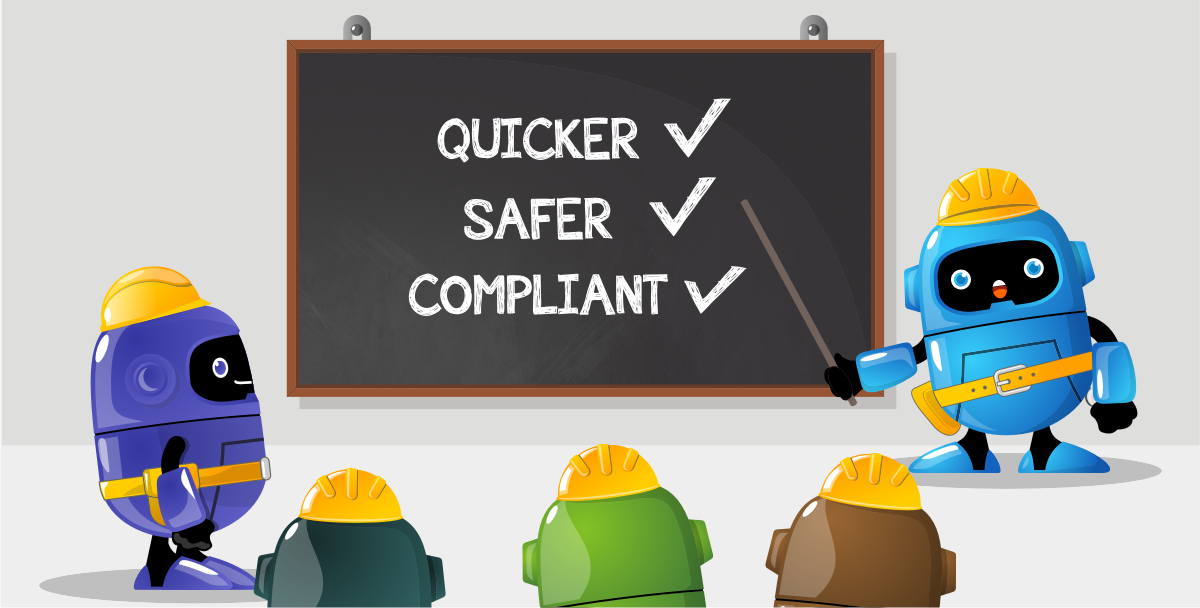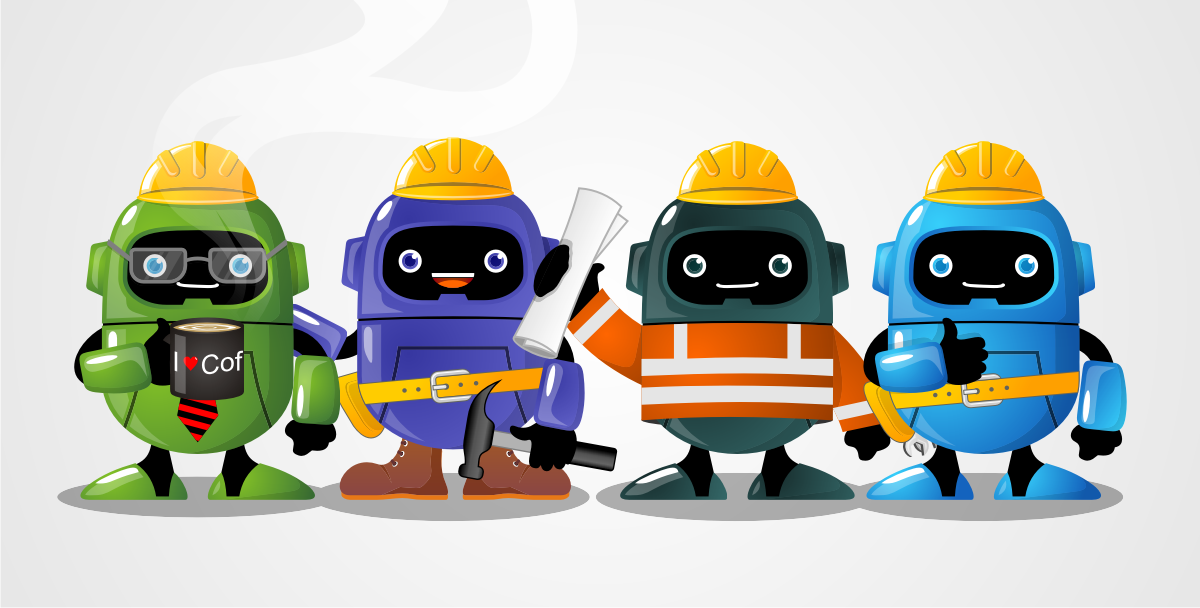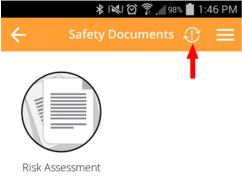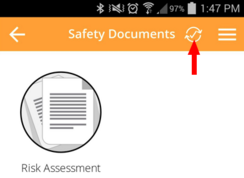How a Simple Process Drives Safety Compliance
Safety management systems have come a long way in the last 250 years. Just think back to workplace conditions during the Industrial Revolution – almost no pay, child labour, very long hours, and extremely dangerous work conditions with exposure to chemicals, accident-prone machinery, and no WHS requirements whatsoever.
But this has changed over the years. Legal reforms and acts were introduced – the Factory Act, the Employer’s Liability Act, and finally, the 1974 Health and Safety at Work Act. This legal document became the foundation for workplace health and safety processes in the UK and the rest of the world. And it led to the increasingly more complex safety processes we have today.
The core purpose of WHS is to keep people safe. Simple. With the increasing complexity of requirements and standards, Business owners, project managers and safety officers alike have to be careful of falling into the trap of using compliance to document requirements like the SWMS as their main measure of WHS compliance. This article looks at why adhering to document requirements is a poor standalone indicator of compliance. We also suggest how a simple safety process drives the success of your WHS compliance.
Documents are Symbols of a Process
Safety isn’t symbolic. It is real and should be treated in the real world, not on a document. Safety management systems do involve documents, but they symbolise a process. For example, a SWMS is a safety planning tool that identifies the risks of high risk construction work and the actions taken to manage those risks. It symbolises the process you are going to take when dealing with the risks and making sure your workplace and its workers are safe from those risks. When it’s under the (judges) hammer, the process symbolised (documented) matters most – not the symbol or the document itself.
Downloading a generic template for your SWMS, JSA, or any other safety document is like taking the symbol without taking the process it represents. And that defeats the whole point of your safety management system and its documents. To comply with WHS requirements, you should be focusing on the processes required to keep your workplace and its workers safe – not just on the documents themselves.
WHS audits look at whether you have followed an effective process that actively reduces the risks in your workplace. They care about if you have actually provided a safe work environment. Not simply whether you have ticked the box of completing a piece of paperwork.
In 2013, The Supreme Court Qld in a case against a QLD construction company for the death of two workers cited:
“work practices focused too much on the work performed onsite and did not pay adequate attention to the dangers presented by the conditions of the site itself”
In other words, not considering risks on the ground, in the real world can have significant impacts when taken to the extremes. Focussing too hard on the details of the tasks to be completed can lead to ignoring all the risks that are actively present
What you focus on matters. And if you want to pass your WHS audit and actually keep your workers safe, then it’s time to focus on the safety management process behind the symbols and documents.
But I still go through a process when filling in a template?
Safety management systems aren’t just about the symbols. They’re about the processes behind them. But you may be wondering – isn’t downloading a generic template still technically a process? Sure. But think about this. What process is more effective at satisfying the Work Health and Safety Act requirement to provide a safe work environment? Is it:
- Find a generic SWMS template on Google, Officeworks or other source
- Complete the boxes provided by the template as best as you can
- Gather up or seek out workers individually and gather signatures
- Store it onsite until the work is done
- Transferring the document to a folder in your office when you are done with the site
Or:
- Identify a the risks onsite, in person
- Build a new SWMS or modify the existing version to cover all task & site-specific risks that are present. Pushed to everyone to sign.
- Monitor how measures are being implemented while work is being completed with real time automated risk rating notifications
- Review by anyone relevant once the work has been completed
- Automatic document storage once complete for any future audits, follow-ups, or learning
From a legal standpoint, the second option is better,
The very purpose of developing a SWMS is to ensure that employers and workers have taken the time to identify the high-risk tasks to be done on site. And then, it is to develop measures to manage these risks and tasks in the context of the work being done. The very nature of a SWMS is that it is specific. It is created specifically in response to a specific site, specific tasks, and specific risks. A generic templated SWMS will not meet the intention behind WHS requirements. Instead, it will defeat the real power of the SWMS and even take away from your safety management.
As WorkSafe Victoria explains, “our concern is not what is written but what actually happens”. A generic SWMS is a symbol of safety that only provides guidance. To focus on the process and comply with WHS requirements, your SWMS and other safety documents need to be customised. It is the second process that is more likely to pass a WHS audit because it demonstrates an active approach to creating a safe work environment. And it is the first process that will get a much more severe punishment when a safety incident does happen, even though both processes are represented by the same type of document.
How to Prioritize the Process
The simplest way to boost the effectiveness of your safety process is to use a digital safety platform like SafeWorkPro. While you can do your safety management physically or digitally, doing it digitally is what will make the difference. Why?
Safety management software simplifies your safety management. Turning a complex process into a simple, easy to understand workflow that allows for an easier way to assess, mitigate, monitor and review workplace risks of all nature. It makes sure that your safety management system is customised, comprehensive, and lets you focus on the process. Leave the document creation, distribution and storage to the software. With safety management software, you can seamlessly customise, prioritise, and ensure your safety management system and its processes exceed WHS regulations.
SafeWorkPro is the Australian safety management software that can make sure your workplace prioritises the process over the symbols.
- Customise your SWMS, JSA, or other safety documents specifically to your worksite using our flexible document builder
- Make sure your specific workplace risks are managed and your workers are safe
- Ensure your company truly complies with WHS requirements
Do all of this seamlessly and in one place with the SafeWorkPro platform. Click the button below to find out more.
More From The SafeWorkPro Blog
How Can a Quality Assessment Review Maintain Safety?
In successful hazard and risk management it is important to keep on top of changes to OHS laws and regulations as well as how strongly your own risk assessment policy is performing. Although there is not much the ordinary business owner can do about government OHS legislation Australia, there is a great deal that can be done to improve risk assessment procedures.
Conducting a regular and in depth risk assessment review can improve safety and eliminate unproductive work practices. It is also a way to answer some of those basic risk assessment questions.

Under requirements outlined in the Work Health and Safety Regulations, a person conducting a business or an undertaking (PCBU) must review risk control measures and revise where necessary. Such a review must take place when:
- a health and safety representative requests a quality assessment review
- consultative arrangements suggest a review is needed
- a new risk or a different hazard is identified
- upcoming workplace changes are likely to present new risks and hazards that current safety measures may not control
- a safety measure fails to effectively control a risk
To identify these potential issues, a consultation process that involves workers, OHS representatives and managers should consider:
- if the control measures are effective both on paper and in practice
- whether the controls measures have inadvertently produced any new risks
- if all hazards were identified
- whether new work practices, equipment or materials/substances produced any new or different risks
- how useful and successful risk assessment training has been for workers
- how directly involved workers are in risk identification
- what effect changes to OHS legislation or laws could have current safe operating procedures
- if the rate and extent of workplace health and safety incidents is decreasing
Any risk assessment review that takes place should be prioritised based on the seriousness and immediacy of the risk. If a hazard is more serious than the control measures used to reduce its associated risk should be review more often. Don’t wait until something goes wrong; begin a review today!
What is Risk and Reasonably Practicable?

The Work Health and Safety Act 2011 requires that duty holders create and maintain an effective safety culture at workplace through active consultation with relevant stakeholders (eg workers, clients, managers), the provision of health and safety information and through other forms of hazard analysis. Specifically the Act requires that all safety risks are either eliminated or minimised as much as is reasonably practicable.
How to define what is reasonably practicable?
A risk assessment is part of determining what is reasonably practicable. The duty holder, usually the person conducting a business or undertaking (PCBU) or the safety manager, must identify the relevant factors that contribute to the risk analysis process. In other words the PCBU must find a balance between what can be done to eliminate or reduce risks, and what is reasonable to do. The control measures used will be different for many worksites but six considerations must be made.
1: What is the likelihood of a risk occurring?
- The more likely it is that a risk eventuates; the more may need to be done to eliminate or reduce it.
2: How much harm may result if a risk were to eventuate?
- The larger the extent of harm; the more importance will be placed on effective control measures.
3: What is known, or should be reasonably known, about the risk and hazard involved?
- Commonly referred to as the state of knowledge, this is what the duty holder knows about a risk and what he/she should reasonably know about a risk. When determining what should be reasonably known about a risk, a duty holder should consult with workers and other stakeholders, complete a risk assessment, investigate previous risk assessments, and review relevant OHS laws and regulations.
4: What is known, or should be reasonably known about the available control measures to be implemented?
- Safe Work Australia’s codes of practice outline possible control measures but duty holders are not required by law to follow them. However OHS laws do require that duty holders make themselves aware of the codes of practice to ensure they understand the full scope of what is reasonably practicable in the elimination or reduction of risk.

5: What is the suitability and availability of control measures to eliminate or reduce risk?
- To ensure a safe workplace whilst maintaining an organisation’s economic competitiveness, the available control measures as well as the practicable ones should be considered. A risk control that is appropriate for one situation or business, may not be practicable for another.
6: What is the cost of eliminating or minimising risks?
- This point should be considered after all other health and safety options have been checked. The cost of implementing a risk control measure is a definite factor in determining what is reasonably practicable. This is because an organisation’s resources may be limited to a certain extent however it should be noted that the WHS Act clearly favours the prioritisation of safety ahead of cost.
In terms of the full scope and size of the WHS Act, this is but a glimpse of the recommendations on determining what is reasonably practicable. Nonetheless, there are valuable points that any business can apply to their safe operating procedures. For more information on the term reasonably practicable you can read Safe Work Australia’s interpretive guidelines.
Risk assessments: How to keep work safety switched on in an offline environment

Out of sight, out of mind


Freedom to Move
Many occupations require work to be undergone in remote regions, often out of reach of internet connectivity. At SafeWorkPro we understand these areas are the ones that require the most meticulous safety procedures, risk assessment document and emergency planning. Therefore we have ensured our applications functionality still runs smoothly when you get that annoying no signal sign on your mobile device. You can still take photos, create documents and assess risk no matter where your work day takes you.
So if you never want to lose access to safety again, sign-up to a trial of SafeWorkPro.



